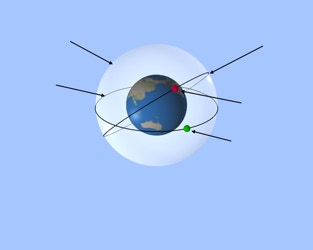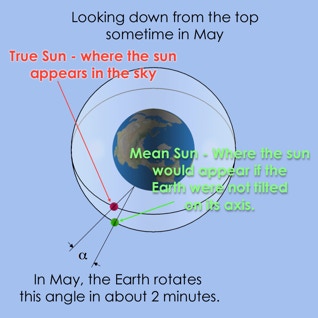The Earth is tilted 23.5˚ on its axis in relation to its orbit around the sun. Like a spinning top, the axis of the spin always points to the same place in space. (Although this is not technically correct, for the purposes of this demonstration, this assumption will be used.)
As the following video demonstrates, the northern hemisphere is tilted towards the sun in the months around June, while the southern hemisphere is tilted towards the sun in the months around December.
This section will continue with three assumptions:
1. the Earth's orbit around the sun is circular.
2. you, the observer, are standing on the equator.
3. while the Earth is actually tilted 23.5° on its axis, for clarity, let’s assume the tilt is 40°.
The point of view will be changed from the Earth orbiting a stationary sun, to the sun orbiting the stationary Earth.
It will be helpful in the discussion to be familiar with all of the terms shown on the following diagram.

Ecliptic - The path of the True Sun throughout the year on the celestial sphere. The angle that the ecliptic makes with the celestial equator is the same as the angle of the tilt of the Earth’s axis.
Celestial Equator - An extension of the Earth’s own equator onto the celestial sphere. It is also the path the Average (mean) Sun would take aroud the celestial sphere if the Earth were not tilted on it’s axis.
True Sun - The actual sun that we see. Its path is on the ecliptic, taking one year to travel once around the celestial sphere.
Select a button to learn more.
Mean Sun - The sun that we would see if the Earth were not tilted on its axis. It also takes one year to travel once around the celestial sphere.
Celestial Sphere - The projection of everything we see in space on an imaginary sphere that surrounds the Earth.
Let's look at the motion of the sun around the earth for one year.
Remember that we are assuming the Earth’s orbit around the sun is circular. The velocity of the Mean Sun and the True Sun are constant, each one taking one year to make a complete trip around the celestial sphere.
What follows is one of the most important concept of what actually is taking place in regards to the analemma and tilt.


Looking at the top view, observe the position of the True Sun and the Mean Sun on the celestial sphere. From the point of the observer on the equator, the True Sun is slightly offset from the Mean Sun. Looking at the bottom view on the right, as the sun moves during the day from East to West, the True Sun has already passed overhead, ahead of the Mean Sun by about 2 minutes.
Let’s go inside of the celestial sphere and watch the path of the True Sun from the Earth as it makes its way around the celestial sphere. Again, the point of view is from the equator looking directly overhead at noon.
Let’s view the same but from outside the celestial sphere.
A few days after the vernal equinox both the mean sun and true sun have moved along their paths THE SAME DISTANCE. But because the path of the true sun is tipped, from the point of view of an observer on Earth, the true sun (red sun) has already passed overhead and is to the right of the mean sun. (The view from above the celestial spahere indicates that the true sun is to the left of the mean sun.)

